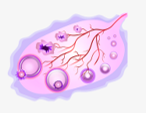If you are trying to fall pregnant naturally, spending some time considering how to optimise your ovulation is important. After all, it has taken your egg around 4 months of hard work to get ready for it (if you haven't read my article on egg quality, you can read it here)
Ovulation happens when a follicle in the ovary empties itself and the egg ‘jumps’ from the ovary into the Fallopian tube. It then travels down the Fallopian tube, where most fertilisation takes place, to the uterus.
There are a few factors that can hinder the ovulation process.
If you have Endometriosis or Endometriomas (also called chocolate cysts) on your ovaries (although Endometriomas are most often found on the left ovary) or your Fallopian tubes, it may:
- Reduce your ovarian reserve (the number of healthy follicles in the ovary)
- Interfere with your hormones. Luteinising hormone levels spike just before your ovulation and provide the trigger for the follicle to release the egg.
- Damage the ovaries with the tissue or cyst ‘stretching’ the ovarian tissue
- Block the Fallopian tubes.
So, what can you do to optimise your ovulation?
1. Track your ovulation
Unlike your period, ovulation can be a bit of a ‘silent’ affair. Some women feel when they ovulate, but many don’t. To fall pregnant, you need to have sex in a 48-hour window around ovulation, so being able to pinpoint the event can be very helpful.
If you have a very regular cycle, the same length every time, then a simple calendar method can help. You will ovulate 14 days BEFORE your next period (not AFTER your last period). So, if you have 28 day cycle, you’ll ovulate on day 14. If you have 30-day cycle, you’ll ovulate on day 16. And if you have a 26-day cycle, your ovulation happens on day 12.
A few more tracking methods can be helpful:
- Basal Body Temperature: a slow steady rise in temperature is caused by the rise in progesterone. Take your temperature first thing in the morning before you even get out of bed.
- Ovulation Predictor Kits help you determine the Luteinising hormone levels in your urine. A sharp rise tells you you’ll probably ovulate in the next 12 to 36 hours. Start testing 5 days before you think you might ovulate to catch the rise.
- Saliva testing. Saliva undergoes chemical changes during ovulation and a saliva test can pick this up and show crystal-like formations at 24-72 hours before ovulation.
- Cervical mucus changes: around your ovulation the consistency of your cervical mucus starts to change. It becomes thinner and clear (a bit like raw egg white). The method works best in addition with the temperature tracking.
2. Avoid chemicals that can disrupt your hormones
Hormones play a key role in ovulation and some chemicals are known hormone disrupters. Chemicals you want to be particularly weary about are plastics (in water bottles and food containers, as they can leak into the liquid or food); dioxins (which are produced when waste and petrol is burned and accumulates in the fatty tissue of animals); phthalates (chemicals that create the fragrance in washing powders, fabric softener, cremes you put on your skin, and in perfumes); phyto-oestrogens (soy products); and pesticides on fruit and vegetables (go organic for berries, spinach, kale and spinach, nectarines and peaches, apples and pears, grapes, celery, tomatoes, and capsicum/bell peppers and chili.
3. Adjust your diet and use supplements
To make sure your ovaries function optimally, you need to reduce your Endometriosis and shrink any endometriomas you have.
The best way to reduce your Endometriosis is the eat a personalised anti-inflammatory diet, by identifying and removing the foods that you are intolerant to, and adding foods that contain anti-oxidants and are anti-inflammatory.
If you have Endometriomas, you may want to consider taking a supplement for N-acetyl-cysteine (NAC). It has shown to be able to shrink your Endometriomas.
For the tailored anti-inflammatory diet and supplements, you will need help from an expert. If you’d like to discuss how you could optimise your ovulation, you can book a free 30-minute Endometriosis SOS Call.
